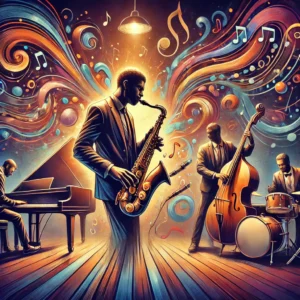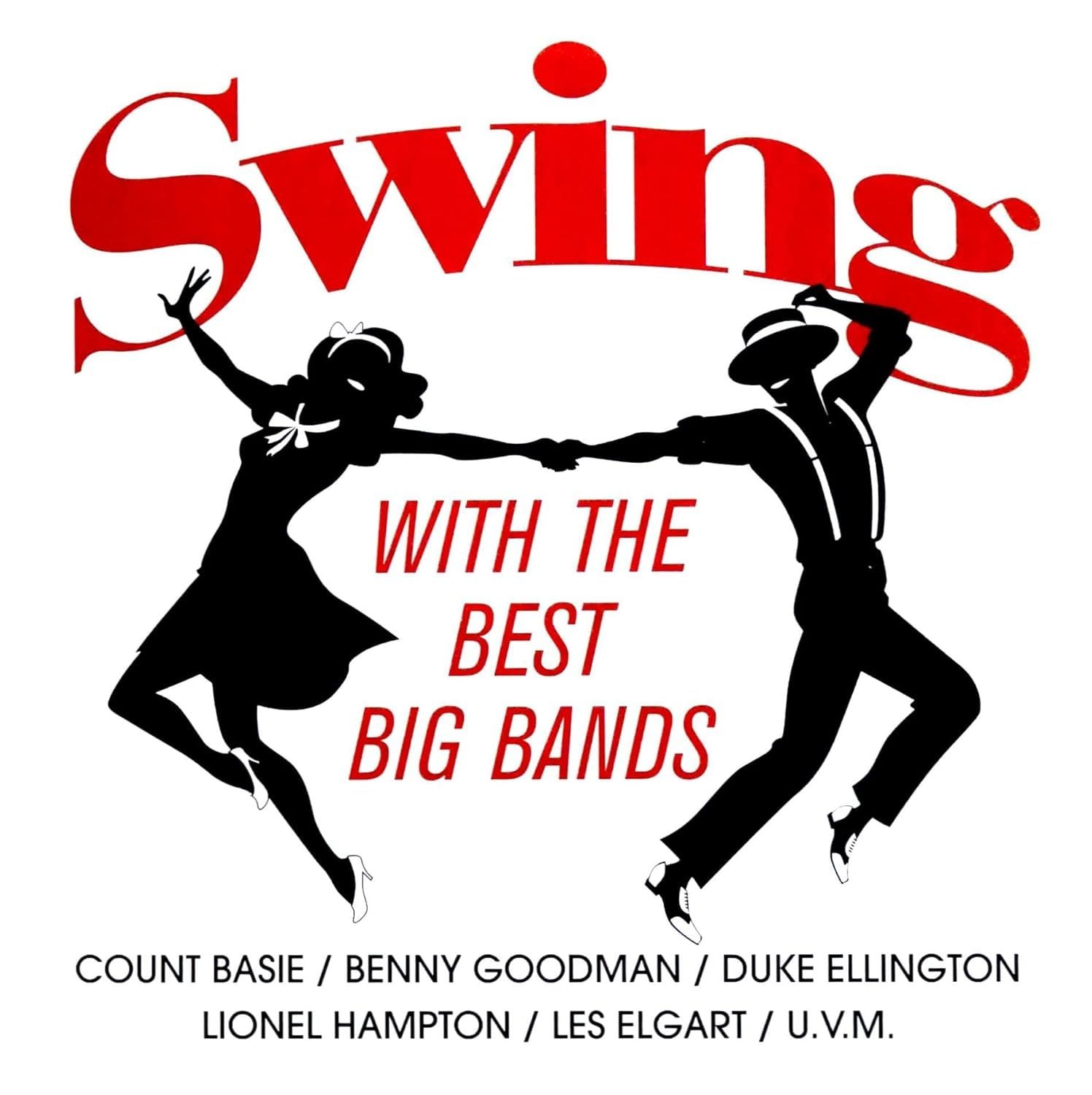Swing techniques in jazz history have taken quite the journey, haven't they? You've got the vibrant grooves of New Orleans bouncing into the big band extravagance of the '30s and '40s, all while riffing off Benny Goodman and Duke Ellington's creativity. It's like watching your dad try to dance—awkward yet somehow charming! From improvisational freedom to tight orchestration, swing invites musicians to strut their stuff. Plus, those electrifying dance styles? They made social gatherings a hoot! Just when you thought swing was a thing of the past, it's made a comeback! Stick around—you're in for quite the jazzy ride!
Key Takeaways
- Swing music evolved from earlier jazz styles, incorporating rhythmic complexity and improvisation that defined the genre's unique sound.
- Fletcher Henderson's arrangements laid the groundwork for swing, transitioning small groups to larger ensembles for richer compositions.
- Innovations in swing techniques included tight orchestration and memorable riffs that enhanced audience engagement and encouraged dancing.
- Drummers became central to establishing the swing feel, providing both grounding and facilitating improvisational freedom among musicians.
- The cultural impact of swing led to various dance styles, showcasing its adaptability and influence on social interactions during the 1930s and beyond.
Historical Roots of Swing Music
Swing music, which emerged in the late 1920s, represents a pivotal moment in jazz history, characterized by its infectious rhythmic drive and danceability.
Now, you might be wondering, how did this all start? Well, let's take a stroll down memory lane, shall we? Early jazz influences like ragtime and blues set the stage, but swing took it up a notch. Imagine that classic sound morphing into something that made you want to dance like nobody's watching—except they totally are!
Regional styles played a huge role too. From New Orleans' lively beats to the sophisticated sounds of Kansas City, each area contributed its unique flavor.
You've got Fletcher Henderson, who was fundamentally the architect, laying down the blueprints for swing arrangements. And then there's Benny Goodman, the "King of Swing," who popularized it all, making us all feel a bit cooler on the dance floor, even if you've got two left feet like me!
As big bands grew in size, they brought a fuller sound to the stage, making everyone want to cut a rug. Seriously, who could resist?
Key Characteristics of Swing Techniques
When you think about swing techniques, you might picture fancy footwork on the dance floor or a drummer sweating it out in the back.
Swing is all about rhythmic complexity and that irresistible urge to improvise, kind of like when you're trying to make a quick meal with whatever's left in the fridge—sometimes you nail it, and sometimes it's just a weird casserole.
Plus, with those catchy riffs and big bands, swing isn't just music to listen to; it's an invitation to get up and dance, even if your moves look more like a baby giraffe learning to walk!
Rhythmic Complexity and Structure
Jazz music captivates listeners with its rhythmic complexity and structure, particularly in the swing genre. You might find yourself tapping your foot or bobbing your head as those syncopated rhythms take hold. It's like the music is giving you a little nudge, urging you to dance, even if your moves resemble a confused chicken. Swing's distinctive rhythmic momentum creates a groove that's impossible to ignore.
The big bands, with their brass and woodwinds, create a beautiful mess—think of it as a polyrhythmic interplay, where each section of the band plays off one another like siblings trying to outdo each other at a talent show. Riffs, those catchy little phrases that repeat, can get stuck in your head, making you want to hum along, even if you're not quite sure how to play an instrument.
What's fascinating is that swing's rhythmic structure isn't easily pinned down. It's fluid, like trying to catch a slippery fish, allowing musicians to interpret the music with their own flair.
Improvisational Freedom and Expression
With the rhythmic complexity of swing as a backdrop, musicians revel in the freedom to improvise and express themselves. It's like being given a canvas but instead of paint, you've got a saxophone, a drum, and a whole lot of rhythm.
You can explore all sorts of improvisational styles, creating a dynamic conversation through music. Imagine calling out a musical phrase, and another player immediately responds—it's like a friendly banter, only way cooler!
As you immerse yourself in swing, you'll find riffs—those catchy little melodies that keep popping up. They're your trusty sidekicks, helping you build variations and showcase your personal flair.
And let's not forget the drummers, who are the heartbeat keeping everything grounded while you venture into complex harmonies. It's as if they're saying, "Go ahead, try something wild!"
The beauty of swing lies in its encouragement of individual expression. You can strut your stuff within the structure of the ensemble.
Dance Integration and Styles
Swing dance styles, like Lindy Hop and Balboa, burst onto the scene in the 1920s and 1930s, bringing energetic movements and improvisation to the dance floor. You might think it's all about fancy footwork, but it's more about the connection you share with your partner. Trust me, those partner dynamics can be a rollercoaster ride—one minute you're twirling, and the next, you're trying not to step on toes!
These styles are like a glorious dance fusion, blending rhythms and steps that make your heart race. Here's a quick look at some key characteristics:
| Dance Style | Key Features |
|---|---|
| Lindy Hop | Playful, energetic, improvisational |
| Balboa | Close embrace, intricate footwork |
| East Coast Swing | Simple, beginner-friendly |
Each dance style has its charm, and mastering them is like trying to untangle your earbuds—frustrating yet oddly satisfying! So, whether you're shimmying through a crowded floor or just trying not to trip over your own feet, the beauty of swing dance lies in the fun and spontaneity you share with your partner. Now, go on, channel your inner swing dancer!
Development of Big Bands
When you think about big bands, just picture a musical party where everyone's invited, and there's a whole lot more room for creativity—like when you try to fit a whole pizza in your backpack!
In the 1930s, these larger ensembles transformed jazz, thanks to legends like Duke Ellington and Count Basie, who surely had a few tricks up their sleeves.
Characteristics of Big Bands
The big band era marked a significant evolution in jazz, characterized by larger ensembles that typically included ten or more musicians. Imagine trying to squeeze all that talent into a tiny room—it's a recipe for chaos!
But in reality, these big bands created a fuller sound, with sections of saxophones, trombones, and trumpets working together in delightful harmony. The band dynamics were a thing to behold, as musicians blended their unique sounds to craft a rich tapestry of music.
Unlike earlier jazz styles, big bands relied heavily on orchestration and written arrangements rather than collective improvisation. This meant more complex performances—kind of like trying to follow a recipe when you usually just wing it in the kitchen!
Riffs became the bread and butter of these arrangements, providing a solid foundation for soloists to shine, while the swing rhythm kept everyone dancing.
And let's not forget the legends like Duke Ellington and Count Basie, who pushed jazz boundaries with their innovative compositions.
It's a reminder that, even in a big band, every voice matters—so don't be afraid to let yours shine!
Influential Big Band Leaders
Big band leaders played an essential role in shaping the sound and direction of jazz during the era. You might think it's all just about the music, but these folks were like the captains of a ship sailing through a stormy sea of rhythms and melodies.
Take Duke Ellington's innovations, for example. His unique compositions weren't just notes on a page; they were like jazz magic, pulling listeners into a world of sound.
Then there's Count Basie's riffs, which were so catchy that even your grandma could tap her foot to them. His band made you want to get up and dance, like you just discovered the last slice of pizza at a party.
And who could forget Benny Goodman? His popularity skyrocketed in the 1930s, making swing music as cool as wearing sunglasses indoors—everyone wanted a piece of that action!
Lastly, let's tip our hats to Fletcher Henderson's rhythms. His orchestra laid the foundation for the big bands that followed, crafting tunes that made even the stiffest dancers want to move.
Influential Figures in Swing Jazz
Swing jazz emerged as a vibrant genre in the 1930s, largely thanks to a handful of influential figures who shaped its sound and style.
You've probably heard of Benny Goodman, right? Known as the "King of Swing," his innovations turned swing music into a national craze, paving the way for big bands everywhere.
Then there's Duke Ellington, whose harmonies and sophisticated arrangements made jazz feel like a fancy dinner party—minus the awkward small talk, of course.
Count Basie brought a whole new flavor with his driving rhythms, creating a sound that made you want to dance—even if your moves resemble a flailing octopus.
And let's not forget Artie Shaw, the clarinet wizard whose arrangements were so inventive, they could make even a classical music snob tap their toes.
Now, if you think you can leave out Billie Holiday, you're mistaken! Her emotive voice and unique phrasing left an indelible mark on swing, influencing countless singers who tried (and usually failed) to capture her magic.
These remarkable figures didn't just play music; they shaped an entire era, and honestly, they made us all want to swing a little harder.
Swing Dance Styles and Their Origins
Originating from the lively atmosphere of the 1920s to 1940s, swing dance emerged as a vibrant expression of rhythm and movement within African American communities.
You might be surprised to learn that swing dancing isn't just one style; it's a whole family of dances, each with its own unique flair and story.
Here are some key styles you should know:
- Lindy Hop: The original swing dance, full of energetic movements and improvisation.
- Balboa: Born in Southern California, it's perfect for crowded dance floors with its close-embrace style.
- Jive Evolution: A high-energy blend, combining elements from Latin dances and rock and roll.
- East Coast Swing: The go-to for beginners, simpler but still a blast.
- West Coast Swing: Adapts to modern music, showing just how versatile swing can be.
These styles not only showcase rhythm variations but also reflect the social context of their time.
They hold cultural significance, giving rise to lively dance competitions where you can show off your skills—just try not to trip over your own feet like I often do!
Cultural Influence of Swing Era
During the Swing Era, which flourished in the 1930s and early 1940s, cultural dynamics in the U.S. shifted dramatically as swing music became the heartbeat of social gatherings. You can almost picture it: folks jiving to lively tunes, the dance floors buzzing with energy, and everyone, regardless of background, joining in.
Swing music wasn't just a genre; it was a cultural exchange, a way for people to connect, laugh, and momentarily forget the struggles of the Great Depression.
You see, swing dancing, especially the Lindy Hop, became a symbol of the Jazz Age. It broke down racial barriers in social settings—who knew that a simple dance could be so revolutionary? Venues like Harlem's Cotton Club were packed, creating a sense of community that felt electric.
And let's not forget the radio and movies, which blasted swing music into every household, shaping social dynamics and fashion trends.
You might even find yourself tapping your foot today, feeling the influence of that era. The global spread of swing during and after World War II left a legacy so strong that it still inspires music and dance cultures worldwide.
Isn't it wild how a little rhythm can change the world?
Innovations in Swing Music
As the Swing Era evolved, musicians began experimenting with larger ensembles that transformed the sound of jazz. Suddenly, it wasn't just a few guys jamming in a smoky club; it was an orchestral affair! These innovations in swing music brought fresh energy and excitement. You might even say it was like jazz on steroids—only without all the side effects.
Here's what made it tick:
- Complex arrangement techniques made the music richer and more engaging.
- Unique rhythmic innovations turned the drums into the heartbeat of the band, creating that irresistible swing feel.
- Melodic themes got a makeover, linking different sections of the band like a well-planned dinner party.
- Riffs became the catchy choruses of swing, luring you in with hypnotic phrases.
- Orchestration tightened up, so you could actually hear each instrument—like a game of musical hide-and-seek!
As these elements intertwined, swing music not only distinguished itself from earlier jazz styles but also opened doors for improvisation.
You couldn't help but tap your feet, even if you were secretly hoping to keep your dance moves under wraps. Trust me, nobody wants to see that!
Revival and Modern Swing Movements
The revival of swing music in the 1990s brought a fresh wave of energy that captivated younger generations. You might've found yourself stumbling into a swing dance club, wondering how everyone seemed to float across the floor. The swing dance resurgence was real, and it was hard to resist the rhythm!
Modern choreography blends traditional styles like Lindy Hop and Balboa with contemporary influences, creating something vibrant and exciting. Just think of it as your favorite pizza topped with unexpected flavors—delicious! Events like the International Lindy Hop Championships really showcase this blend, offering a platform for talent to shine.
To really get a sense of this revival, here's a quick comparison:
| Aspect | Traditional Swing |
|---|---|
| Styles | Lindy Hop, Balboa |
| Modern Integration | Popular Music Influences |
| Community Events | International Competitions |
Thanks to social media, you can now connect with swing dancers worldwide, sharing techniques and those amusing dance fails you're probably too shy to post! Bands like the Cherry Poppin' Daddies keep the music relevant, making you want to hit the dance floor, even if you've two left feet!
Future Directions in Swing Jazz
Swing jazz is poised for an exciting evolution as it embraces modern technology and diverse musical influences.
Seriously, if you thought swing was just about fedoras and fancy footwork, think again! With artists diving into digital collaboration and genre fusion, swing jazz is ready to strut into the future.
Here's what's cooking in the swing pot:
- Blending Traditions: Musicians are mixing classic swing with funk, hip-hop, and electronic sounds.
- Global Reach: Thanks to digital platforms, artists can now connect and collaborate worldwide, sharing their sounds with the masses.
- Dance Culture: The ongoing swing dance revival keeps live performances lively and engaging, creating a community vibe.
- Improvisation: Emerging artists are getting creative, adding personal flair while still keeping that swing rhythm alive.
- Festival Fun: Jazz festivals and streaming platforms are making swing jazz more visible, attracting younger fans who can't resist a good groove.
Conclusion
So, there you have it—the swing era's rhythm still echoes today, much like my attempts to dance to it (spoiler alert: it's not pretty). Did you know that during the height of the swing era, big bands often had over 20 musicians? That's a lot of people to fit in a tiny club! Swing's evolution is like a never-ending party, and who knows? Maybe one day you'll find your groove, too. Keep swinging, my friend!


